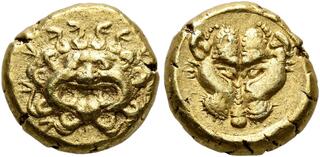| Leu Numismatik AG > Auction 15 | Auction date: 1 June 2024 |
| Lot number: 89 Price realized: This lot is for sale in an upcoming auction - Bid on this lot  | Show similar lots on CoinArchives Find similar lots in upcoming auctions on |
| Lot description: LESBOS. Uncertain mint. Circa 478-428/7 BC. Hekte (Electrum, 9 mm, 2.61 g, 11 h). Facing gorgoneion with protruding tongue. Rev. Confronted heads of two panthers, giving the impression of a single facing head; all within shallow round incuse. Linzalone -. Rosen -. SNG Copenhagen -. SNG von Aulock -. Apparently unpublished. A highly unusual and interesting piece with wonderful iconography. Struck from a slightly worn obverse die, otherwise, good very fine. Ex Leu 14, 14 October 2023, 90 and previously from a British collection of electrum coins from Lesbos and Ionia, formed in the early 2000s. The emergence of this spectacular hekte raises several important questions, not least where it was minted. We know the obverse type, a facing gorgoneion with protruding tongue, was popular in Kyzikos, but such an origin is precluded by the absence of a tunny on the obverse, and of a quadripartite incuse square on the reverse. A closer relative appears in the long-running electrum series from Mytilene on Lesbos (Bodenstedt 19.1-2), a city that replaced its initial plain reverse incusa with rich imagery early on. In fact, it is the reverse iconography that makes our coin stand out, for what looks like a simple facing head of a panther is actually composed of two confronted panther heads! Similar confronted animal heads do occur on a number of electrum, silver and billon coins from Lesbos in the late 6th and 5th centuries, showing two calves, two rams, and two boars, although they do not form a facing head. Furthermore, we do know that the Lesbians experimented with optical illusions, most notably on two types of hektai, which depict two confronted and overlapping female heads (Bodenstedt 55 and 62). However, two confronted heads also forming a single facing panther head is hitherto unheard of, and hence of great historical and artistic interest. Given its iconographical cousins, a Lesbian origin of our coin seems very likely, even though the circular incuse would be unusual for Mytilene and perhaps points to a different mint on the island. The coin has a rather Archaic look to it, but with a convex rather than an incuse reverse image, it is unlikely to have been struck before 478 BC, when Lesbos was 'liberated' from the Persians and joined the Delian League. Facing heads of big cats are known from other mints such as Samos, Messana (as Zankle), and Rhegion, the latter of which issued a silver coinage with a surprisingly similar-looking facing head of a lion. However, these Rhegion tetradrachms date to the 420s-387 BC, which is too late to have influenced our coin, for which we suggest a date in the 470s-450s BC, and certainly no later than 428/7 BC, following Bodenstedt's order of the Mytilenean coinage. Estimate: 5000 CHF |  |



